If you want to know about the sanitary facilities requirements in building or arrangements for various plumbing fixtures or water supply requirements for building, please click the link.
The provision of adequate and appropriate sanitary facilities is a crucial aspect of building design and construction, and is regulated by the National Building Code (NBC) of India.
The NBC provides guidelines for the minimum number of toilets required in buildings based on the type of building, occupancy, and number of occupants. This helps ensure that there is adequate and appropriate provision of toilets to meet the needs of the building’s occupants.
Some of the key requirements for sanitary facilities in buildings as per the NBC of India are:
- There should be at least one water tap and arrangement for drainage in the vicinity of each water closet or group of water closet in all the buildings.
- Each dwelling unit on premises shall have at least one water closet, one kitchen wash place or a sink, and one bathing place or shower to meet the basic requirements of sanitation and personal hygiene.
- All other structures for human occupancy or use on premises shall have adequate sanitary facilities, but in no case less than one water closet and one other fixture for cleaning purposes.
1) For residences
i) Dwelling with individual convenience shall have at least the following fitments
- One bathroom provided with a tap and a floor trap.
- One water closet with flushing apparatus with an ablution tap. and
- One tap with a floor trap or a sink in kitchen or wash place.
Where only one water closet is provided in a dwelling, it is desirable to have the bath and water closet separately accommodated.
ii) Dwellings without individual conveniences shall have the following fitments
- One water tap with floor trap in each tenement,
- One water closet with flushing apparatus and one ablution tap bath for every two tenements, and
- One bath with water tap and floor trap for every two tenements.
3) For buildings other than residences
The requirements for fitments for drainage and sanitation in the case of buildings other than residences shall be in accordance with Table given Below.
i) Office building
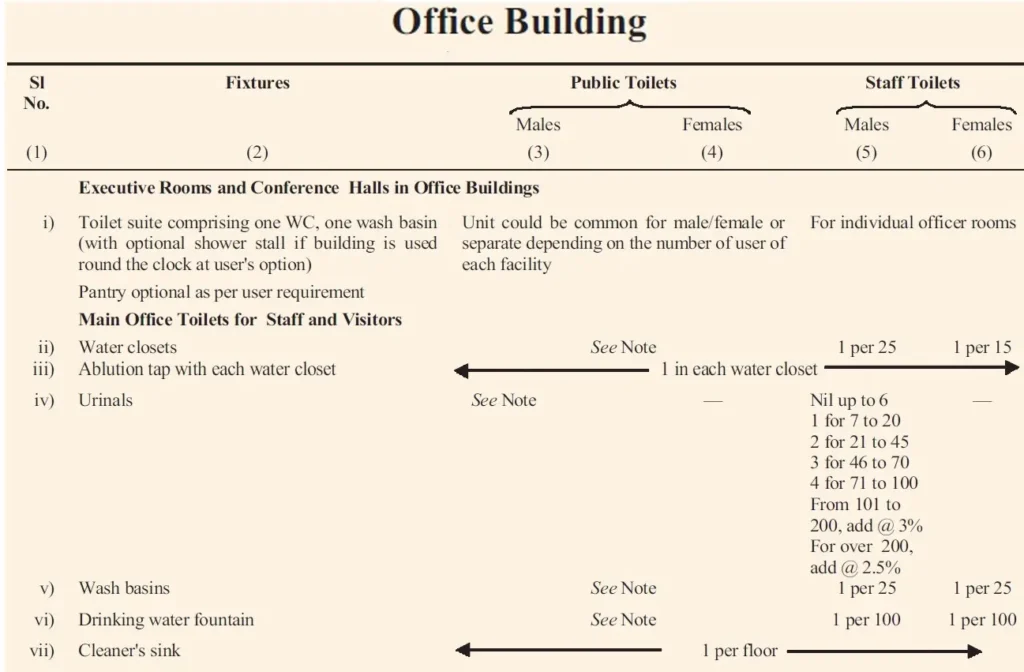
Note
- Staff and public toilet utilities are generally common in office buildings.
- Where public toilets are to be provided independently, similar requirements as that of staff toilet may be provided.
ii) Factory building

Note
- For factories requiring workers to be engaged in dirty and dangerous operations or requiring them to being extremely clean and sanitized conditions additional and separate (if required so) toilet facilities and if required by applicable Industrial and safety laws and the Factories Act shall be provided in consultation with the user.
- Depending on the type of disability of a person and the hazard posed by the type of activities in the factory for a person with disabilities, if a person with disabilities is decided to be engaged for a particular activity, the requirements of accessibility shall be guided by the provisions.
iii) Cinema, Multiplex cinema, Concert & Convention Hall, Theatres & Stadia
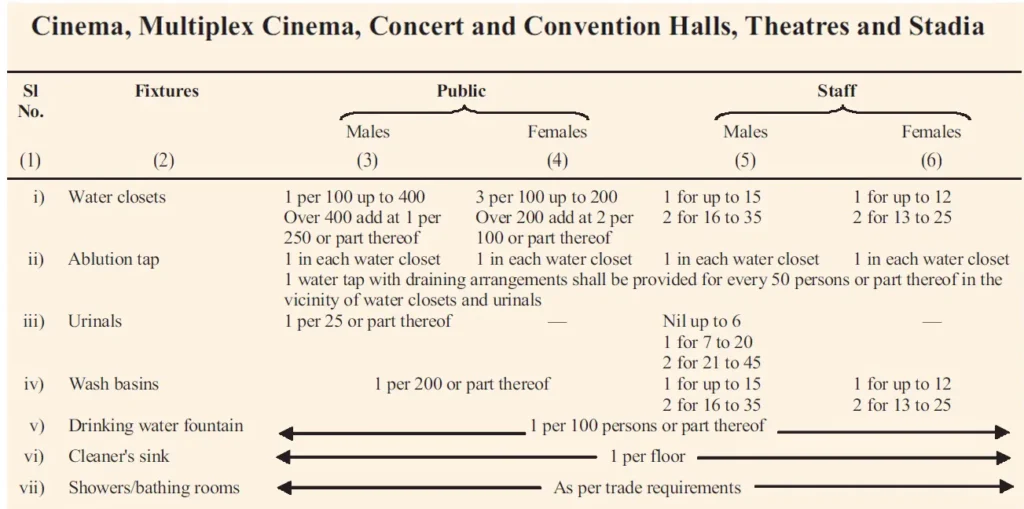
Note
- Some WCs may be Indian style, if desired.
- Male population may be assumed as two-third and female population as one-third.
iv) Art galleries, Libraries & Museums
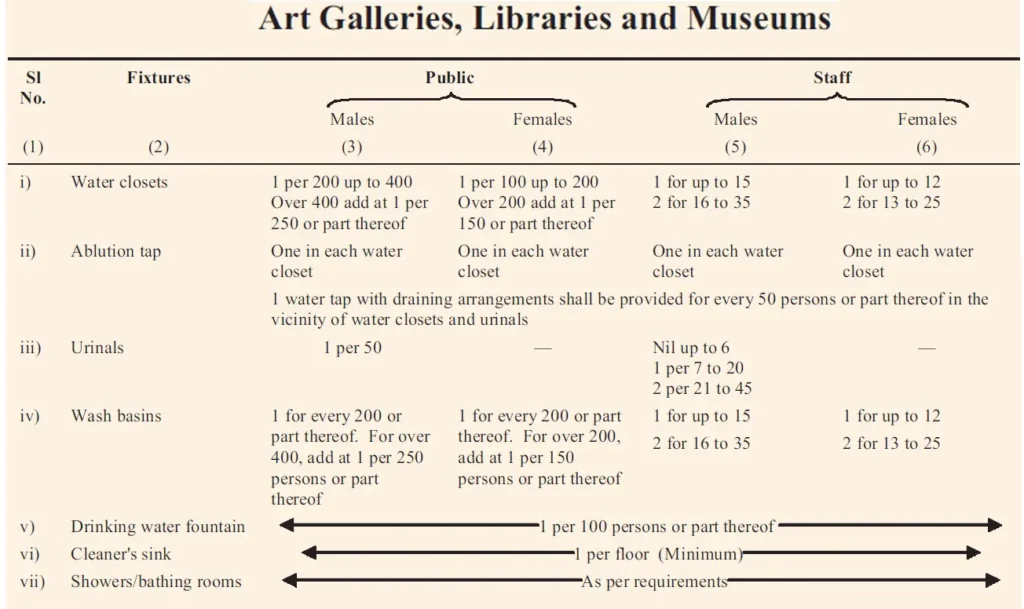
Note
- Some WCs may be Indian style, if desired.
- Male population may be assumed as two-third and female population as one-third.
v) Hospitals with indoor patient wards
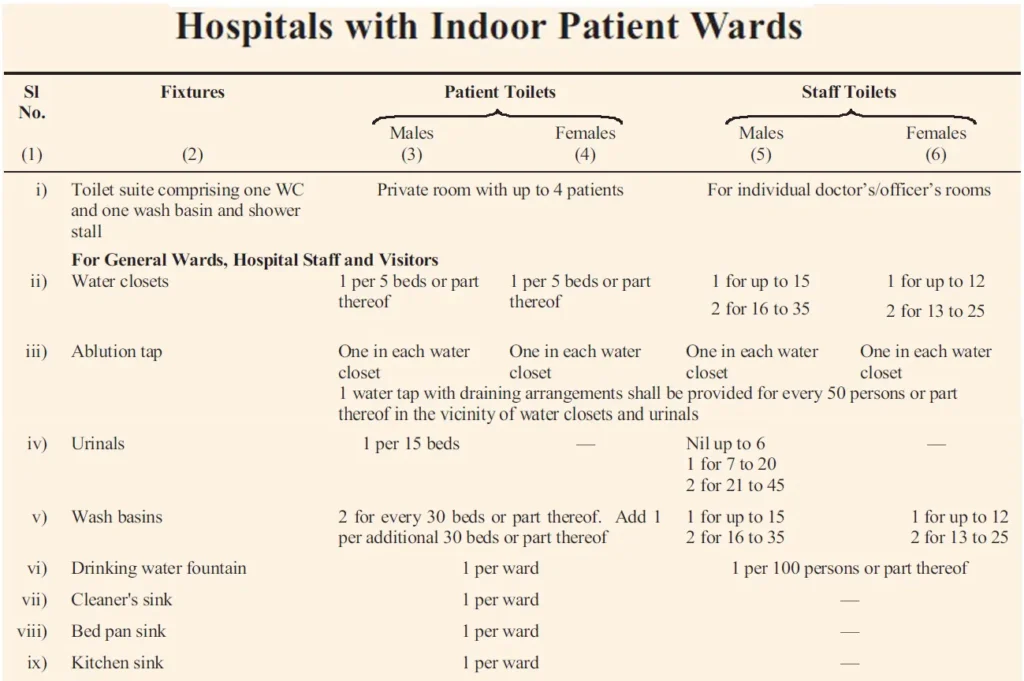
Note
- Some WCs may be of Indian style, if desired.
- Male population may be assumed as two-third and female population as one-third.
- Provision for additional and special hospital fittings where required shall be made.
- Drinking water fountains are not recommended for hospitals for reasons of infection control. This is to be decided by the health authority recommendations.
vi) Hospitals with outdoor patient department

Note
- Some WCs may be Indian style, if desired.
- Drinking water fountains are not recommended for hospitals for reasons of infection control. This to be decided by the health authority recommendation.
- The WCs shall be provided keeping in view the location of main OPD waiting hall and sub-waiting halls, floor wise, so as to serve the people effectively. The number of patients shall be calculated floor wise. The OPD population shall include patient attendants @ at least 1 per patient.
- Male population may be assumed as two-third and female population as one-third.
- Provision for additional and special hospital fittings where required shall be made.
vii) Hospitals, administrative building
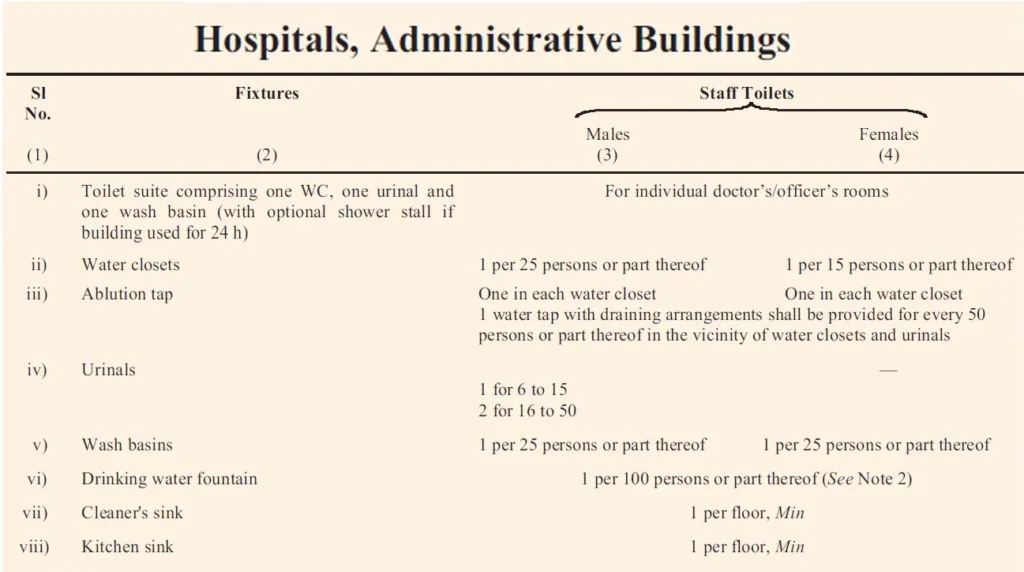
Note
- Some WCs may be Indian style, if desired.
- Drinking water fountains to be provided only when it is a separate block and patients will not use it.
viii) Hospitals staff quarters and nurses homes
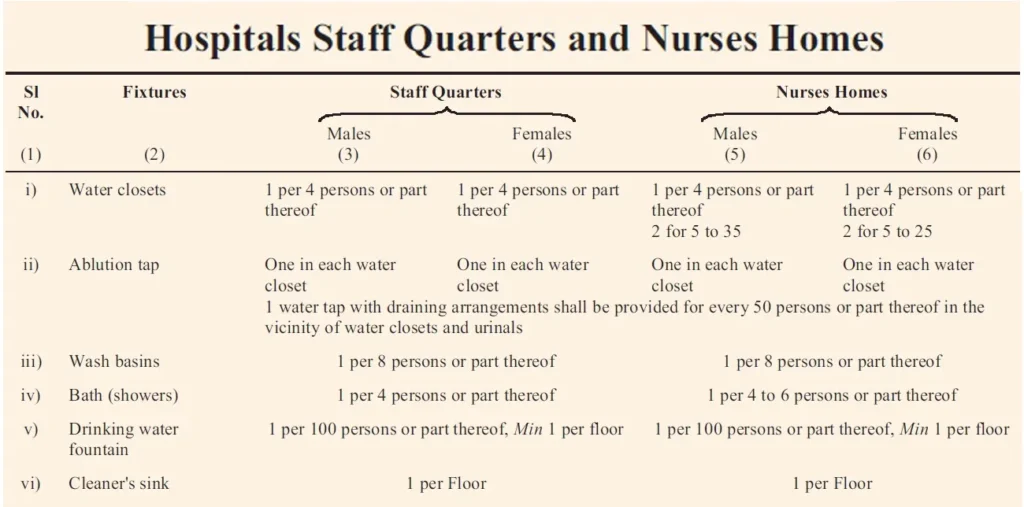
Note
- Some WCs may be Indian style, if desired.
- For independent housing units, fixtures shall be provided as for residences.
ix) Hotels

Note
- Some WCs may be Indian style, if desired.
- Male population may be assumed as two-third and female population as one-third.
- Provision for additional and special fittings where required shall be made.
x) Restaurants
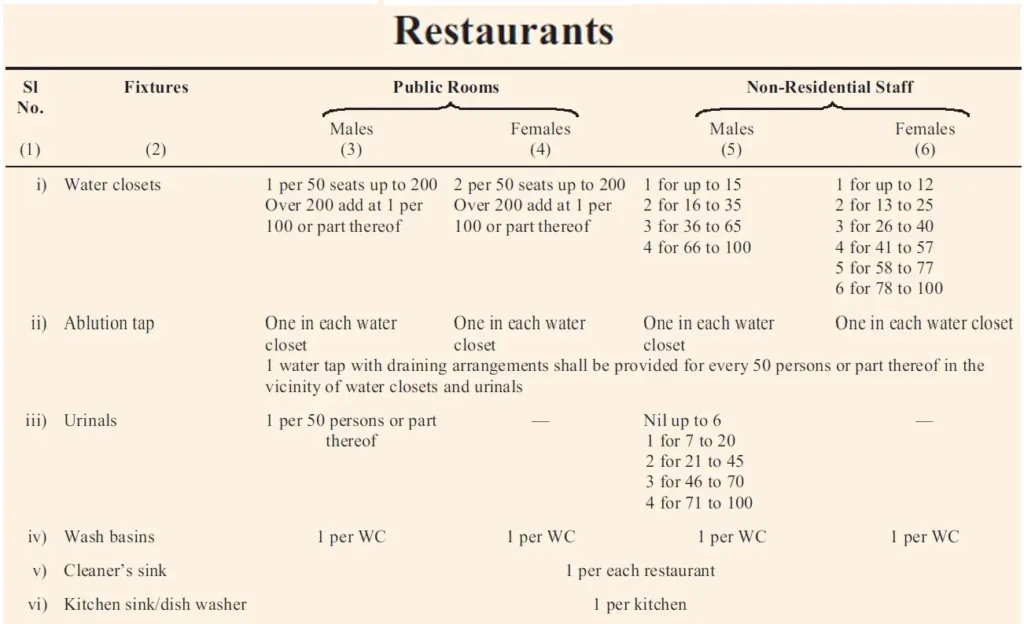
Note
- Some WCs may be Indian style, if desired.
- Male population may be assumed as two-third and female population as one-third.
- Provision for additional and special fittings where required shall be made.
xi) Schools & Educational institutions
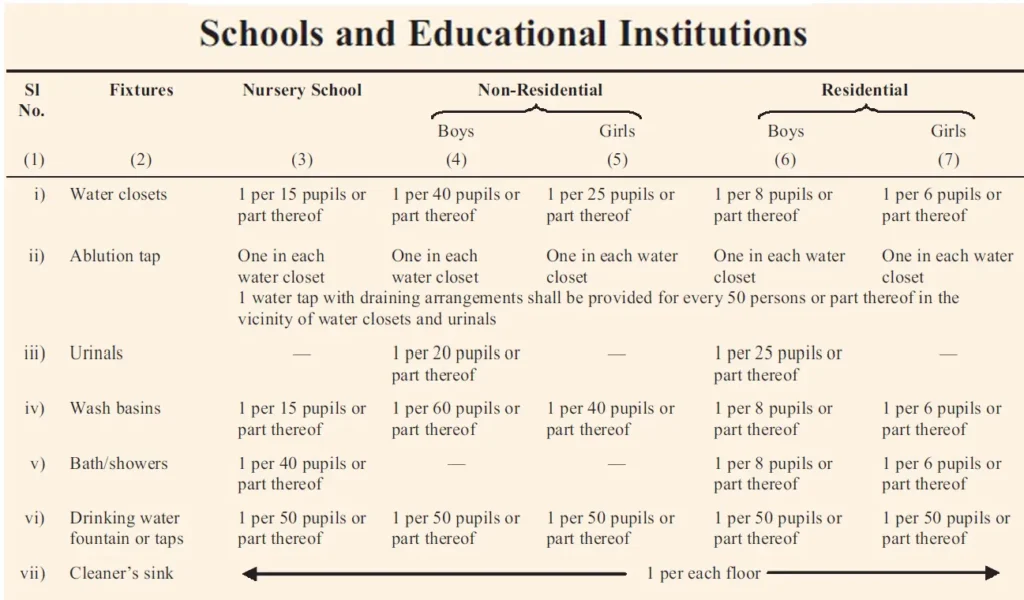
Note
- Some WCs may be Indian style, if desired.
- For teaching staff, the schedule of fixtures to be provided shall be the same as in case of office building.
xii) Hostels

Note
- Some WCs may be Indian style, if desired.
xiii) Fruit & vegetable markets
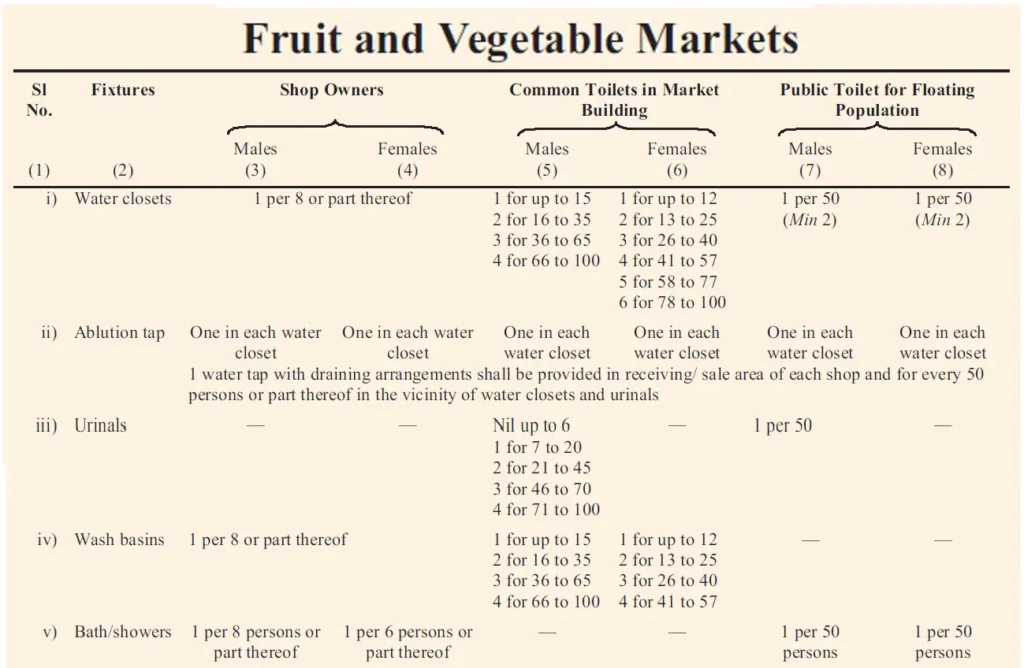
Note
- Toilet facilities for individual buildings in a market should be taken same as that for office buildings.
- Common toilets in the market buildings provide facilities for persons working in shops and their regular visitors.
- Special toilet facilities for a large floating population of out of town buyers/sellers, labour, drivers of vehicles for whom special toilet (public toilets).
xiv) Bus stations, airports & railway stations

Note
- Some WCs may be Indian style, if desired.
- Male population may be assumed as three-fifth and female population as two-fifth.
- Separate provision shall be made for staff and workers.
xv) Shopping malls and retail buildings
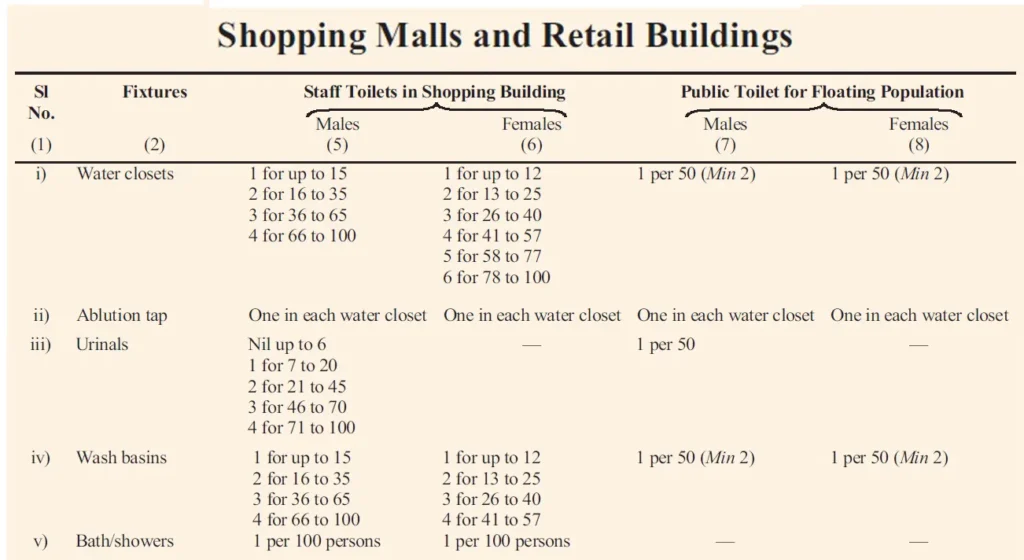
Note
- Toilet facilities for individual facilities in a shopping building should be taken same as that for office buildings.
- Staff toilets in the shopping buildings provide facilities for persons working in shops and building, as well as for maintenance staff.
- The number of persons against the fixture bath/showers represent the maintenance staff requiring such facility.
- Public toilet facilities are provided for a large floating population for buyers and visitors.
The following shall be, in addition, taken into consideration
- The figures shown are based upon one fixture being the minimum required for the number of persons indicated or part thereof.
- Building categories not included in the tables shall be considered separately by the Authority.
- Drinking fountains shall not be installed in the toilets.
- Where there is the danger of exposure to skin contamination with poisonous, infectious or irritating material, wash basin with eye wash jet and an emergency shower (safety shower with eye wash unit) located in an area accessible at all times with the passage/right of way suitable for access to a wheelchair, shall be provided.
- When applying the provision of these tables for providing the number of fixtures, consideration shall be given to the accessibility of the fixtures. Using purely numerical basis may not result in an installation suited to the need of a specific building.
- For example, schools should be provided with toilet facilities on each floor. Similarly, toilet facilities shall be provided for temporary workmen employed in any establishment according to the needs; and in any case one WC and one wash basin shall be provided.
- All buildings used for human habitation for dwelling, work, occupation, medical care or any purpose detailed in the various tables, abutting a public sewer or a private sewage disposal system, shall be provided with minimum sanitary facilities as per the schedule in the tables. In case the disposal facilities are not available, they shall be provided as a part of the building design for ensuring high standards of sanitary conditions in accordance with this section.
- Workplaces where crèches are provided, they shall be provided with one WC for 10 persons or part thereof, one wash basin for 15 persons or part thereof, one kitchen sink with floor trap for preparing food/milk preparations. The sink provided shall be with a drinking water tap.
- In all types of buildings, individual toilets and pantry should be provided for executives, and for meeting/seminar/conference rooms, etc., as per the user requirement.
- Where food is consumed indoors, water stations may be provided in place of drinking water fountains.
In conclusion, the NBC of India provides comprehensive guidelines for the provision of sanitary facilities in buildings, taking into account the needs and comfort of users, as well as safety and health considerations. These guidelines help ensure that sanitary facilities are functional, accessible, and safe for use.